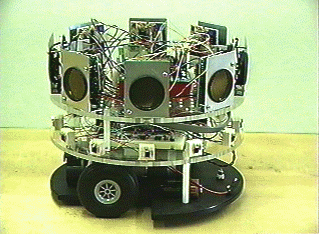ME412 (Autonomous Mobile Robots 2025)
Past Projects
ME412 (Autonomous Mobile Robots 2024)
ME412 (Autonomous Mobile Robots 2023)
ME412 (Autonomous Mobile Robots 2022)
ME412 (Autonomous Mobile Robots 2021)
ME412 (Autonomous Mobile Robots 2020)
ME412 (Autonomous Mobile Robots 2019)
ME412 (Autonomous Mobile Robots 2018)
ME412 (Autonomous Mobile Robots 2017)
ME436 (Autonomous Mobile Robots 2016)
ME412 (Autonomous Mobile Robots 2015)
ME412 (Autonomous Mobile Robots 2014)
ME412 (Autonomous Mobile Robots 2013)
ME412 (Autonomous Mobile Robots 2012)
ME412 (Autonomous Mobile Robots 2011)
ME412 (Autonomous Mobile Robots 2010)
ME412 (Autonomous Mobile Robots 2009)
ME412 (Autonomous Mobile Robots 2008)
ME412 (Autonomous Mobile Robots 2007)
EID111 (Self-Replicating Habitats)
ME412 (Autonomous Mobile Robots 2006)
ME412 (Autonomous Mobile Robots 2005)
MAR
"Mobile Autonomous Robot"

Video of Subsumption!
Video of Fire-Fighting
(Example 1)!
Video of Fire-Fighting
(Example 2)!
Video of Fire-Fighting
(Example 3)!
Video of Fire-Fighting (Example 4)!
Welcome to my mobile robot project web site!
What is a "mobile robot" anyway?
"an intelligent connection of
perception to action"
-Jones and Flynn, Mobile Robots: Inspiration to
Implementation
As my thesis requirement for a Masters degree in Mechanical Engineering at The Cooper Union for the Advancement of Science and Art in New York City, I developed a mobile robot under the advisement of Dr. C. Stan Wei, Professor of Mechanical Engineering. MAR (Mobile Autonomous Robot) is a microprocessor based, programmable mobile robot, that can sense and react to its environment. The purpose of the robot is to serve as a tool for experimental and educational projects in mobile robotics. Included in this page are links to some demonstrations featuring movies with MAR in action! Scroll down to to Demonstrations. For more description of MAR, read on.
MAR is controlled autonomously by the Handy Board, a popular microprocessor based robot controller designed for personal and educational robotics projects. The Handy Board was selected over other microprocessor boards because of its inherent ease of application to mobile robotics. In addition, its operating system software supports Interactive C, a C-like programming environment. Due to the similarity to C, anyone who is familiar with C (which includes much of the academic world) can understand and learn the language easily. Also, the Handy Board e-mail forum, headed by Prof. Fred Martin of The Media Laboratory at MIT, allows users to exchange thoughts about the Handy Board and other Robotics topics.
MAR's mobility is provided by a differential drive system with shaft encoders for feedback control. This system consists of two active wheels, each which rotate independently. Thus, steering is accomplished by one wheel rotating faster than or in the opposite direction to the other wheel. Shaft encoders are used for odemetry sensing. This means that the distance the robot travels (or more precisely, the amount of rotation of each wheel) can be measured.
To detect features in its surroundings, MAR has ultrasonic and IR sensors. The Ultrasonic sensors measure the distance between the robot and an object. The way this works is: the sensor sends out a sound signal (in ultrasonic frequencies) and waits for that signal to reflect off an object and bounce back to the sensor. The time lapse between sending and receiving the signal can be used to calculate the distance (knowing the speed of sound in air). The IR sensors measure proximity of objects. The way this works is: an IR LED emits a light signal. Then if an object is close enough to the robot, the detector detects the reflected return signal much like in the ultrasonic sensor case. Except, there is no measure of distance this time because the speed of light is so fast, it will take really sophisticated timing circuitry to measure such a tiny time lapse. Thus it detects the "proximity" of objects.
Well, that's a brief summary of MAR. Below are some demonstrations with movies of the robot doing it's thing. The first demonstration is subsumption, a revolutionary new approach to robot software architecture. The second is an example application to an international robot fire-fighter contest held in North America.
Subsumption
Subsumption is a result of work by Prof. Rodney Brooks and the Mobile Robot Group at the MIT Artificial Intelligence Laboratory. It is a control architecture where sensor data is used to initiate robot behaviors. This control architecture provides an alternative to the traditional modeling/planning paradigm. In effect, rather than having the robot follow a predetermined path after processing sensor information, the robot is programmed to react to its environment by exhibiting a series of behaviors. All behaviors of the robot run in parallel to enable quick response times, but the behavior that takes control of the robot is determined by an hierarchical classification. This makes the robots actions resemble reflexes.
Click here for the subsumption demo and video.
Trinity College Fire Fighting Home Robot Contest
This demo is modeled after The Trinity College Fire Fighting Home Robot Contest, an annual event where people from around the world compete by building a robot that can find and extinguish a fire in a model of a house. The goal of the robot is to score points while moving through the model, detect a lit candle, and then extinguish it. This simulates a real world application of a future autonomous fire-security robot operating in a factory, office, as well as home setting.
Click here for the fire-fighting home robot demo and video.
Copyright © 2002 Ericson Mar mar@cooper.edu
Please let me know if you have any comments. :)
Last Updated: 3/30/99